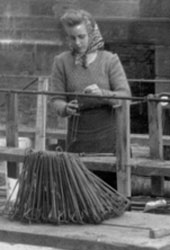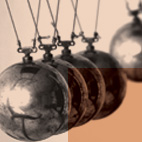|

The name change of 1918 is not connected with any change in the profile, status or organisational form of the Stuttgart college, in contrast to all previous changes. It took place in the context of a major political change. The demise of the Württemberg monarchy in 1918 had made the adjective "Royal" obsolete. For almost the next 50 years, Stuttgart would be home to a College of Technology – the longest-serving title it has had to date.
The far-reaching political developments of the 20th century thus did nothing to change the name of Stuttgart College of Technology. However, they naturally brought about far-reaching changes for the college itself, both good and bad.
The stages in the college's history in National Socialist Germany are marked on the one hand by a democratisation of the college's administrative structure and the expansion of the natural sciences and engineering, and, on the other hand, an economic crisis, overcrowding at universities, increasing unemployment, a lack of identification with the republican state and widespread openness among students for nationalist and racist thinking. Under National Socialism Stuttgart College of Technology was also placed under central control in accordance with the Führer Principle, and was the target of National Socialist university policy proposals, which envisaged measures such as moving the college to Tübingen, where it would be merged with Tübingen University and with the College in Hohenheim. Yet the beginning of the Second World War in autumn 1939 put an end to these plans.
The Second World War changed teaching and research at the college at all levels. Students numbers initially fell even further compared to the pre-war period, then rose considerably above the 1939 level as the war went on. Research activities were focused on important war-related projects. The running of the university was increasingly disrupted by air raids, and from late 1943 onwards institutes were transferred to the region around Stuttgart if possible. By the end of the war around three quarters of buildings and facilities had been destroyed.
In February 1946 teaching recommenced at the college after a ten-month break. The professors' political credentials were submitted to a review, and a sizeable number were temporarily or permanently dismissed. Those wanting to study in Stuttgart had to serve several months' "building service" beforehand so that important buildings could be rebuilt with the college's own resources. Tables in the student refectory assuaged the worst of the hunger in the first few post-war years.
As life normalised and the economy began to recover, a time of growth and expansion also began for Stuttgart College of Technology. This brought one of the major long-term problems back to the fore: there simply wasn't enough space in the city centre, especially for the technical disciplines, which were growing in number and rapidly expanding. Thus, the most remarkable expansion of the College of Technology began to take shape in the new university site in Pfaffenwald in Stuttgart-Vaihingen, which was agreed upon in 1955 after a fierce debate, and which opened its doors in 1957 when the first departmental buildings were inaugurated.
| 1878 - 1922 |
Carl Julius (von) Bach
Professor of Mechanical Engineering |
| 1918 |
Renamed Stuttgart College of Technology |
| 1921 |
Stuttgart Student Support Association
Merger of various support organisations into "Stuttgart Student Support Association", the predecessor of the Students' Association |
| 1921 |
Democratisation of the college
Foundation of the General Student Board (AStA); new college constitution, including election of Vice-Chancellor by Full Professors, election of section heads by professors |
| 1922 |
General Section receives right to confer PhD
General Section (Humanities) is also awarded the right to confer doctorates, thus placing the college on a par with the University of Tübingen |
| 1923 |
Foundation of the Association of Friends of the College of Technology
The aim of the association is "... to support Stuttgart College of Technology in training its students and in its academic research work, and to provide funding to that aim, as well as to provide teaching aids and equipment in natura that cannot be provided by the state."
First chairman: Robert Bosch |
| 1924 |
Foundation of the German University Ring
Exclusion of all students of "non-German origin" from the Ring leads to a consolidation of racist thinking |
| 1925 |
Introduction of compulsory physical exercise
Intermediate Diplomas are only awarded to those who have taken part in physical exercise courses for two semesters |
| 1926 - 1931 |
Debate on future location of college
The aim is to create a central university complex at a new site; locations considered are the Rosenstein Park, Hohenheim, Weißenhof, Degerloch and Ludwigsburg.
The global economic crisis puts an end to the relocation and expansion plans. |
| 1929 |
100th anniversary
Association of Friends of the College donates 670,000 Reichsmarks on the occasion of the anniversary; a donation of 100,000 Reichsmarks is made by an anonymous "other party" for guest lectures by external academics |
| 1931 |
Introduction of one-year compulsory work duty
Compulsory work duty is introduced in view of the global economic crisis, mass unemployment and a "surplus of academics" |
| 1933 |
Honorary doctorate for Hitler
Stuttgart College of Technology awards Hitler an honorary doctorate; however, Hitler refuses to accept the title |
| 1933 |
Expulsion of university members of Jewish origin
The "Law on the Restoration of the Civil Service" provides the legal basis for the expulsion |
| 1933 |
Introduction of the "Führer Principle"
The Vice-Chancellor is the head of the college and is appointed by the Württemberg Minister of Culture (from 1935 by the German minister for Education); he in turn nominates the Deans |
| 1934 |
Introduction of lectures on National Socialism
Lectures cover Germans abroad, racial hygiene, military science and other subjects |
| 1934 |
"Constitution of the German Student Body" comes into force
"The German Student Body represents all students ... Its main objective is to educate the students to be honourable and true German men and to serve the people and state with commitment and selflessness through compulsory SA service, work duty, and political training." |
| 1935 |
Guideline on the Standardisation of the College Administration
Central control of all higher education institutions from Berlin by the German Ministry for Science and Education |
| 1936 - 1968 |
Adolf Leonhard
Professor of Electrical Engineering (suspended between 1946 and 1952) |
| 1941 |
Minor Reform
The five Sections are reorganised into three Faculties (Natural Sciences, Civil Engineering and Mechanical Engineering) in preparation for the foundation of a Württemberg Central University (a merger of Hohenheim, Stuttgart and Tübingen) planned by the National Socialists |
| 1941 - 1947 |
Evacuation of institutes
Relocation of individual institutes to locations such as Neckarhausen, Tailfingen and Schwäbisch Gmünd |
| 1944 |
Air raids on Stuttgart
Most of the college buildings and facilities are destroyed |
| 1945 |
Refectory and food for students
A student refectory is built from private contributions; the city of Stuttgart sponsors 10 free tables a week (2.75 RM) and provides trucks for the delivery of food; lunches made available in companies and private homes; Hoover food programme financed by American donations |
| 1946 |
Stuttgart College of Technology reopens
after a 10-month break in teaching |
| 1946 - 1947 |
Reconstruction duty
Prospective students are required to perform 6 - 8 months of reconstruction duty before studying at the college |
| 1946 - 1948 |
Denazification process
Measures are taken to rid the college of supporters of National Socialism |
| 1947 |
Students' Association is refounded |
| 1949 - 1978 |
Max Bense
Professor of Philosophy and Theory of Science |
| 1950 |
General Studies programme is launched |
| 1950 |
College Advisory Committee is created
Consists of representatives of the college, state government, the city and the business community; its objective is to strengthen links between the college and the public |
| 1954 |
The "Stuttgart Miracle"
Reconstruction of destroyed and damaged institutes from state funding, and grants by the city, the refounded Association of Friends of the College of Technology, the German Donors' Association for the Promotion of the Sciences and the Humanities, and the German Research Foundation (DFG); construction of a student hall of residence from an endowment by the US-German Max Kade; construction of a new student refectory |
| 1955 - 1957 |
New sciences site at Pfaffenwald
A lack of space at the college leads to a new site debate; in 1956 the state government decides on the Pfaffenwald site; building of the first institute starts in 1957 |
| 1957 - 1977 |
Käte Hamburger
Professor of Literature and Aesthetics |
| 1961 |
K I building opened
Inauguration of the K I (Kollegiengebäude 1) building and the university library in the city centre |
| 1963 |
Expansion plan / teaching qualification courses
The Senate approves an expansion plan to allow teaching qualification courses to be held and to offer students of the music and arts academies the opportunity to study a subsidiary subject as part of a teaching qualification |
| 1964 |
K II building opened
Inauguration of the K II building in the city centre |
| 1964 - 1990 |
Frei Otto
Founder and head of the Institute for Light Two-Dimensional Structures (IL) |
| 1967 |
Renamed Universität Stuttgart |
 |
 |
|
 |
